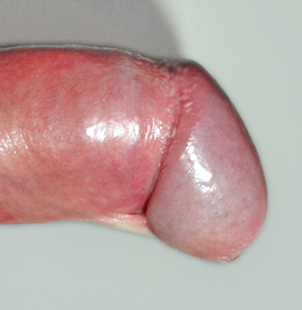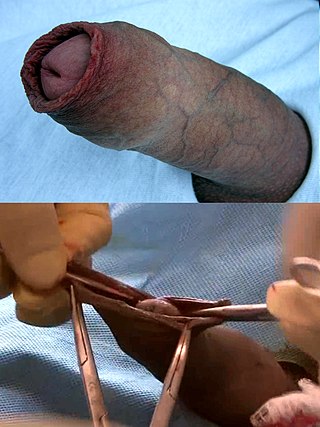Gallery
- A removed frenulum preputii penis
- Before and after frenuloplasty
- Healing of frenuloplasty
- Before and after frenoloplasty
| Frenuloplasty of prepuce of penis | |
|---|---|
| Other names | Release of frenulum |
| Specialty | Urology |
A frenuloplasty of prepuce of penis (also known as a release of frenulum) is a frenuloplasty of the frenulum of prepuce of penis.
An abnormally short or sensitive frenulum of the penis can make some types of sexual activity uncomfortable or even painful. This may be a complication of circumcision or a naturally occurring event. When it is a naturally occurring event, a short frenulum can restrict normal retraction of the foreskin during erection (a condition known as frenulum breve). The goal of treatment is to allow normal retraction of the foreskin. Circumcision may relieve this condition but is not indicated solely for treating frenulum breve.[ citation needed ]
The procedure usually involves the removal of the frenulum or the creation of an incision in the frenulum that is then stretched to lengthen it and stitched closed. The incision can be z-shaped, y-shaped or a single horizontal cut. Once healed, the procedure effectively elongates the frenulum, allowing normal function. Under normal circumstances the incision heals completely in around six to eight weeks, after which time normal sexual activity can resume. Other methods of treatment include horizontal stitches in the frenulum which over the course of a week cut through the tight skin, elongating it. This is generally more painful than the standard procedure, but heals faster. [1]
Another reason for the treatment is to correct a rare complication of a frenulum breve which presents as scars on the frenulum, these scars cause pain and make normal sex very difficult and are caused by the rubbing of the frenulum whilst engaging in sexual activity. These scars only affect those with frenulum breve. The frenuloplasty can be conducted under both general or local anesthesia. [2]
One study suggests around 15–20% of men require additional circumcision after a frenuloplasty, because not all symptoms indicating the surgery improved. [3] The British Association of Urological Surgeons (BAUS) estimates this number to be lower at 2–10%. [4] Frenuloplasty might avoid the need for circumcision even when a clinician felt circumcision to be indicated at presentation. [3]
A swelling of the penis occurs in 10–50% of patients after operation, usually lasting a few days. Reduced sensation in the glans penis is reported in 2–10% of patients. Below 2% of patients experience an infection of the incision requiring antibiotics or further treatment. [4]

In male human anatomy, the glans penis or penile glans, commonly referred to as the glans, is the bulbous structure at the distal end of the human penis that is the human male's most sensitive erogenous zone and primary anatomical source of sexual pleasure. The glans penis is present in the male reproductive organs of humans and most other mammals where it may appear smooth, spiny, elongated or divided. It is externally lined with mucosal tissue, which creates a smooth texture and glossy appearance. In humans, the glans is located over the distal ends of the corpora cavernosa and is a continuation of the corpus spongiosum of the penis. At the summit appears the urinary meatus and at the base forms the corona glandis. An elastic band of tissue, known as the frenulum, runs on its ventral surface. In men who are not circumcised, it is completely or partially covered by a fold of skin called the foreskin. In adults, the foreskin can generally be retracted over and past the glans manually or sometimes automatically during an erection.

Paraphimosis is an uncommon medical condition in which the foreskin of a penis becomes trapped behind the glans penis, and cannot be reduced. If this condition persists for several hours or there is any sign of a lack of blood flow, paraphimosis should be treated as a medical emergency, as it can result in gangrene.
Phimosis is a condition in which the foreskin of the penis cannot stretch to allow it to be pulled back past the glans. A balloon-like swelling under the foreskin may occur with urination. In teenagers and adults, it may result in pain during an erection, but is otherwise not painful. Those affected are at greater risk of inflammation of the glans, known as balanitis, and other complications.

A frenulum or frenum is a small fold of tissue that secures the motion of a mobile organ in the body.
Dyspareunia is painful sexual intercourse due to medical or psychological causes. The term dyspareunia covers both female dyspareunia and male dyspareunia, but many discussions that use the term without further specification concern the female type, which is more common than the male type. In females, the pain can primarily be on the external surface of the genitalia, or deeper in the pelvis upon deep pressure against the cervix. Medically, dyspareunia is a pelvic floor dysfunction and is frequently underdiagnosed. It can affect a small portion of the vulva or vagina or be felt all over the surface. Understanding the duration, location, and nature of the pain is important in identifying the causes of the pain.

Hypospadias is a common malformation in fetal development of the penis in which the urethra does not open from its usual location on the head of the penis. It is the second-most common birth defect of the male reproductive system, affecting about one of every 250 males at birth, although when including milder cases, is found in up to 4% of newborn males. Roughly 90% of cases are the less serious distal hypospadias, in which the urethral opening is on or near the head of the penis (glans). The remainder have proximal hypospadias, in which the meatus is all the way back on the shaft of the penis, near or within the scrotum. Shiny tissue or anything that typically forms the urethra instead extends from the meatus to the tip of the glans; this tissue is called the urethral plate.

Chancroid is a bacterial sexually transmitted infection characterized by painful sores on the genitalia. Chancroid is known to spread from one individual to another solely through sexual contact. However, there have been reports of accidental infection through the hand.

Balanitis is inflammation of the glans penis. Balanoposthitis is the proper term when the foreskin is also affected. Balanitis on persons in diapers must be distinguished from redness caused by ammoniacal dermatitis.

Frenulum breve, or short frenulum, is a condition in which the frenulum of the penis, which is an elastic band of tissue under the glans penis that connects to the foreskin and helps contract it over the glans, is too short and thus restricts the movement of the foreskin. The frenulum should normally be sufficiently long and supple to allow for the full retraction of the foreskin so that it lies smoothly back on the shaft of the erect penis.
Preputioplasty or prepuce plasty, also known as limited dorsal slit with transverse closure, is a plastic surgical operation on the prepuce or foreskin of the penis, to widen a narrow non-retractile foreskin which cannot comfortably be drawn back off the head of the penis in erection because of a constriction (stenosis) which has not expanded after adolescence.

The frenulum of the penis, often known simply as the frenulum or frenum, is a thin elastic strip of tissue on the underside of the glans and the neck of the human penis. In men who are not circumcised, it also connects the foreskin to the glans and the ventral mucosa. In adults, the frenulum is typically supple enough to allow manual movement of the foreskin over the glans and help retract the foreskin during erection. In flaccid state, it tightens to narrow the foreskin opening.

In human anatomy, the penis is an external sex organ through which males urinate and ejaculate. The main parts are the root, body, the epithelium of the penis including the shaft skin, and the foreskin covering the glans. The body of the penis is made up of three columns of tissue: two corpora cavernosa on the dorsal side and corpus spongiosum between them on the ventral side. The urethra passes through the prostate gland, where it is joined by the ejaculatory ducts, and then through the penis. The urethra goes across the corpus spongiosum and ends at the tip of the glans as the opening, the urinary meatus.
Urethroplasty is the surgical repair of an injury or defect within the walls of the urethra. Trauma, iatrogenic injury and infections are the most common causes of urethral injury/defect requiring repair. Urethroplasty is regarded as the gold standard treatment for urethral strictures and offers better outcomes in terms of recurrence rates than dilatations and urethrotomies. It is probably the only useful modality of treatment for long and complex strictures though recurrence rates are higher for this difficult treatment group.

Clitoral hood reduction, also termed clitoral hoodectomy, clitoral unhooding, clitoridotomy, or (partial) hoodectomy, is a plastic surgery procedure for reducing the size and the area of the clitoral hood in order to further expose the glans of the clitoris.

A dorsal slit is a single incision along the upper length of the foreskin from the tip to the corona, exposing the glans without removing any tissue. An ancient practice, it has been a traditional custom among a number of peoples, particularly Filipinos and Pacific Islanders, probably for thousands of years.

Frenulectomy of the penis is a surgical procedure for cutting and removal of the penile frenulum, to correct a condition known as frenulum breve. This condition prevents the full retraction of the foreskin with or without an erection.

In male human anatomy, the foreskin, also known as the prepuce, is the double-layered fold of skin, mucosal and muscular tissue at the distal end of the human penis that covers the glans and the urinary meatus. The foreskin is attached to the glans by an elastic band of tissue, known as the frenulum. The outer skin of the foreskin meets with the inner preputial mucosa at the area of the mucocutaneous junction. The foreskin is mobile, fairly stretchable and sustains the glans in a moist environment. Except for humans, a similar structure known as a penile sheath appears in the male sexual organs of all primates and the vast majority of mammals.

Circumcision surgical procedure in males involves either a conventional "cut and stitch" surgical procedure or use of a circumcision instrument or device. In the newborn period, almost all circumcisions are done by generalist practitioners using one of three surgical instruments. In the US, the Gomco clamp is the most utilized instrument, followed by the Mogen clamp and the Plastibell. They are also used worldwide.

Webbed penis also known as buried or concealed penis is an acquired or congenital condition in which the scrotal skin extends onto the ventral penile shaft. The penile shaft is buried in the scrotum or tethered to the scrotal midline by a fold or web of skin. The urethra and erectile bodies are usually normal. Webbed penis is usually asymptomatic, but the cosmetic appearance is often unacceptable. This condition may be corrected by surgical techniques.
A penile injury is a medical emergency that afflicts the penis. Common injuries include fracture, avulsion injury, strangulation, entrapment, and amputation.